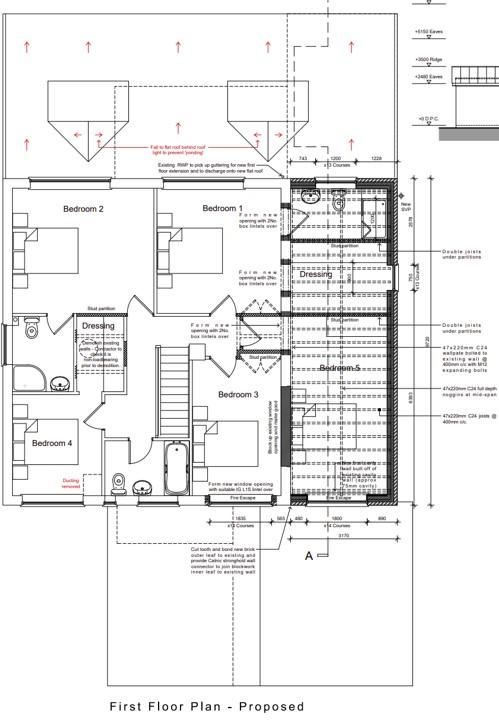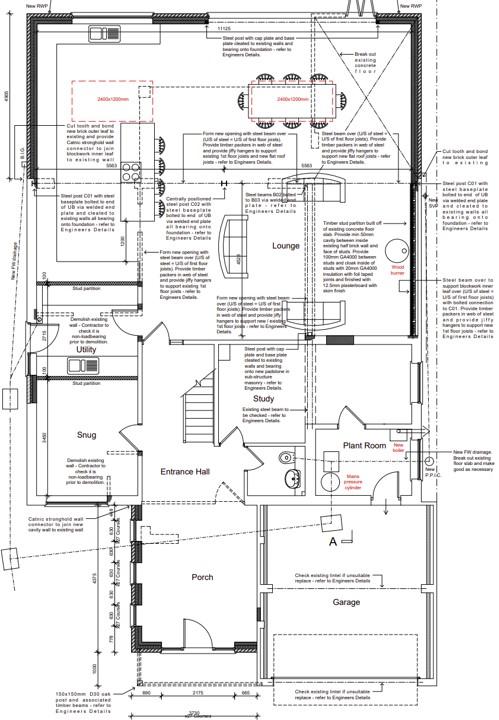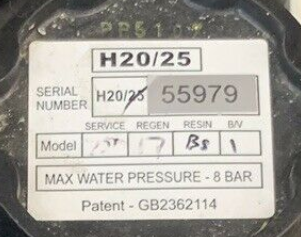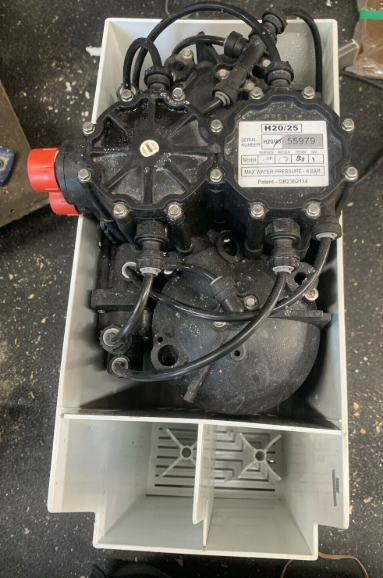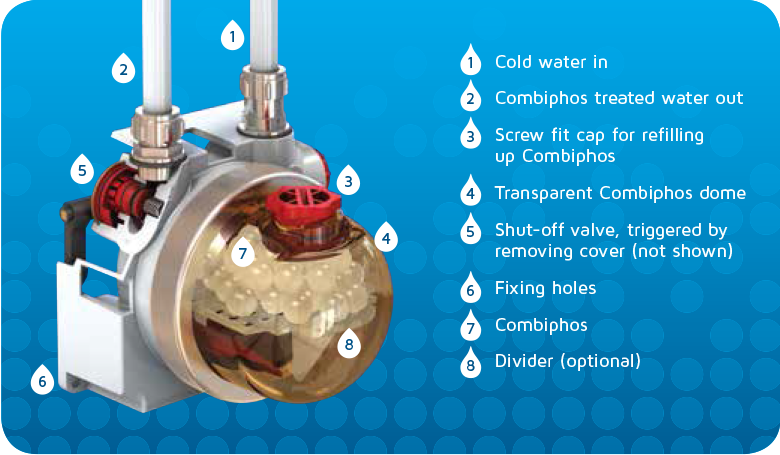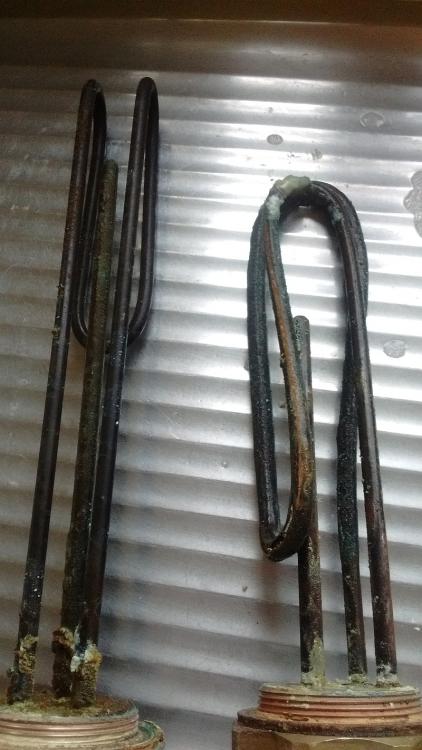Search the Community
Showing results for tags 'water softener'.
-
Afternoon all, I've been browsing the forums for a while, messaged a few users direct but as we are fast approaching water tight I'm after a steer from the group on all things plumbing...... Attached are a couple of pictures of what will be the finished ground and first floor plans. The existing house is/was heated using a warm air boiler (located in what will become a snug) ducting through floor to ground floor rooms and into the loft and into 1st floor via ceilings. hot water was previously provided by an electric hot water cylinder (i know $$$) located on the first floor. (Cold Water tank in the loft) Mains gas and water come into the house in the snug (it used to be the kitchen). The intention is to re-route the mains water/gas to a plant room accessed off the garage which will house new System Boiler Unvented Cylinder Water Softener Heating will be provided by radiators in bedrooms, snug, study (8 Rads) towel radiators in bathrooms/ensuite (4 Rads) underfloor heating in open plan kitchen/living room and porch This will be a completely new plumbing system with all existing plumbing decommissioned as the job goes on as we are still living in the house as while work progresses. The first floor joists run side to side (across the front) of the house, except the rear extension which runs front to back. Up until last week I was intent on using a branch/tee plumbing system for the hot water and central heating (because that's what I was familiar with) but I then realised how much more common the manifold systems have become. I've plumbed in plastic before when renovating our last house and I like the idea of using a manifold system because it gives a continuous run of pipe to the appliance/rad (reducing scope for leaky fittings at junctions/turns etc) but I also note the issues with having to empty fairly long sections of pipe before it receives hot water, to give an idea of scale the house is about 12m wide 14m deep. In terms of design my questions to you lovely people would be, should I Use one manifold in the plant room to serve CH pipe runs to all rads and towel rails and secondary manifolds serving the UFH? In respect of DHW and CW run a feed to each bathroom and install a manifold in each bathroom (therefore a using a shower means a significantly shorter length of pipe needs to be vacated for the sink hot tap)? Is running a manifold off another manifold a no, no in terms of maintaining consistent water pressure etc? In terms of manifolds etc, I'm familiar with 15mm, 22mm etc. but I'm seeing reference to 10mm, 16mm across some brands. Is there a preferred brand of pipe, manifold etc. you would recommend? I'll probably have more questions as we go on but I am actively scouting threads looking for answers etc. so thank you in advance for all the contributions
-
- renovation
- manifolds
- (and 10 more)
-
Really don't want to spend £800 on a unit, so have been looking out for used units. There's a local one up for grabs which needs a new Harveys h20 twin tank (not electric): Regen: 17; Resin BS How does that tie in with hardness levels? If not adequate, can I change any settings on the unit? @PeterStarck I recall you had a Harvey with your hardness at 320ppm (mine is 301) - are you able to reset the regeneration cycling/timing? Currently sold as spares as according to the chap selling it, the riser tube ( described as 'the small tube that runs from the bottom to the top external to the two big tanks') is cracked. Would that be this part? https://www.wrekinwatersofteners.co.uk/wrekinwatersofteners/final.asp?id=1906 I know @JSHarris has some experience with repairing these units. Are these fairly easy to repair or engineered in such a fashion that you have to break it even more to repair it? If this unit can deal with hardness just over 300ppm, I'll have a visit this weekend to inspect it.
-
As an alternative to a conventional salt-gobbling, kitchen-cabinet filling, water-wasting softener, I'm planning on installing a whole-house Combimate (made by Cistermiser). This is one of those polyphosphate micro-dosing thingies (it adds about 2–3 ppm of food-grade polyphosphate, which sequesters the dissolved calcium, so reducing scale). @JSHarris almost certainly knows about the idea, but I thought of him when I read the claim that it's also good for red/brown water from boreholes. I was going to get a BWT Combicare from ScrewFix, but was put off by DIYnot denizens saying they often plug up with scale, which is kinda ironic. Or there's a similar Italian product I found on FleaBay. So anyone got experience of these things? Do they work? Do they keep working after a few years?
- 199 replies
-
- hard water
- water softener
-
(and 1 more)
Tagged with:
-
Hi Can anyone recommend a water softener that will work on 6 bar pressure? BWT and Monarch seem to be limited to 5 bar Thanks
-
My understanding is that most people put their water softener on the ground floor under the kitchen sink. I'm not sure why that is, but my plumber has suggested that as the unit is quite big and as the kitchen sink cold feed won't be softened water so that we can drink it, we might as well put it where there is more space, which is by the UVC on the second floor. This is also very close to all three bathrooms, though further away from the guest WC which will be the only cold outlet on ground floor to have softened water. Can anyone see any downside of siting the water softener on the second floor? The only possible negatives I can see are: Cold water pipe length to the two bathrooms on first floor will be a bit longer as cold water would have to go up from the stop cock on ground floor to second floor and then back down to first, instead of straight up to first; cold water feed to guest WC on ground floor will also be longer for the same reason, but presumably this isn't really an issue because the pipe run would be no longer than the hot water as that needs to go up to the cylinder first anyway, and as hot and cold will be balanced I shouldn't lose any additional pressure. Have I got that right? Or will there be some pressure loss? Our pressure is about 3 bar (sometimes falls slightly below this) but flow rate should make up for that as Thames Water is currently digging up our road to do our upgrade to a wider pipe that should give us plenty of flow. The only upside is that we gain quite a bit of space under the kitchen sink and make it easier for the plumber to install, so if there is a loss of pressure, perhaps it's better not to do this.
-
I live in a very hard water area. Was going to install a water softener, but saw a presentation on the Halcyon conditioner system and it looks impressive. Anyone used this or have any experience or views on that?
-
I have a non-branded non-electric twin tank (tablet salt) water softener that I purchased from EMWC in 2005. EMWC appear to still sell the same model under the name "Homewater" but the installation instructions refer to it as the "300" model. Various other companies also currently sell "Homewater 300" models, some of them state this is manufactured by Harveys. The main components inside mine are marked as H20-750 (Regen=17, Resin=135 or B5 or BS hard to tell, B/V=1) and searching for this has led me to various sources of information that state the main innards are indeed manufactured by Harveys. My serial number ends in 34191, so earlier than the one shown in the photo at the top of this thread: https://forum.buildhub.org.uk/topic/9729-used-water-softener-harvey-twin-tank-worth-a-risk/. The innards look almost identical, but the threaded connections to the valves on the meters are different on mine (long and narrow, as opposed to short and wide). I think I may also have an older brine valve/float assembly to the one shown in that thread (and it is not located between the 2 tanks, instead on its own at the back corner of the cabinet). My softener was purchased new at the end of 2005. It was in servce until we moved in 2009. It was then stored in my new garage until 2018 (never quite got around to plumbing it in!). I finally installed it in the "new" house in late 2018 (and sanitised it) and it has been in service working well until now. So 4yrs in service at old property, 9yrs in storage, and 2yrs in service at new property. I have come across the Wrekin Water site where I see they stock a good selection of spares for this softener, but I wonder if anyone can help me identify which component might be at fault if I explain the problem? Recently I noticed a drop in water pressure/flow at all soft outlets in the house. But it was intermittent. It has been getting worse over the last few weeks, it is now barely a trickle when at its worst, but at other times it has excellent flow. A bit of trial and error has led me to think that one of the tanks (or parts associated with the flow through just that tank) has an issue. If I do a manual regeneration to swap to the other tank, the soft water flow is amazing. If I do another manual regen to swap back, the flow is dreadful again. These are the characteristics I have noted when in the 2 states: Regen of Tank A, service from Tank B: Trickle at soft outlets upstairs. Downstairs outlets start OK then fade (so water being drained from the pipes). Brine tank gets drained, then refilled, regen completes in <20mins, draining stops. Still poor flow at soft outlets after regen. ... Regen of Tank B, service from Tank A: Excellent flow at ALL soft outlets. Brine tank doesn't appear to be getting drained, or atleast it is taking a very long time. Some time later (I got bored of watching), the brine tank refills. I assume regen has completed BUT... There is still a continuous (slow) flow out of drain. I couldn't find anythin like a service manual online but I did manage to find the patent associated with the apparatus and reading this through and looking at the diagrams I think I have a reasonable understanding of how this is supposed to work now. So I was thinking whether this would likely be a fault with the shuttle valve, or the mechanical meter(s) and/or valves therein that control the shuttle valve? Meter lever/valve service kit is £48. Replacement shuttle valve is £132. I have a few options: 1) Diagnose (with your help!), purchase offending replacement part, fit/service myself 2) Call someone in to do the same 3) Get my unit fully reconditioned (Sandy's on eBay do a full mail-off recondition for £480) 4) Buy a second hand serviced/reconditioned unit (£300+) 5) Buy a new unit (£640-£800) Given that my unit is so old and was in storage for some time I am concerned that 1) and 2) might only be a temporary solution and something else may go wrong later (e.g. the resin). I'm nervous of a second hand unit for similar reasons. I was thinking of getting my unit fully reconditioned but what with a new lockdown being announced I'm a little concerned this may take much longer than the stated ~1wk turnaround. So I'm almost resigning myself to buying a new unit. They can be had for ~£640 with 1yr warranty, or ~£800 with 5yr warranty and fitting kit. I don't need another fitting kit and I'm not sure if a 5 yr warranty is worth the extra cost? I would really appreciate any help on the likely fault, and advice on the way forward from members of this forum. Thanks.
- 12 replies
-
- harvey
- water softener
-
(and 1 more)
Tagged with:
-
Thought I would drag out the 31 year old elements from my old cylinder. They came out easier than expected. The one on the right is the lower 'night' element and lasted 30 years before it went, the one of the left is the top element and is still good. What is that jelly though, have I created a new life form.
- 42 replies
-
- water
- soft water
-
(and 2 more)
Tagged with:

